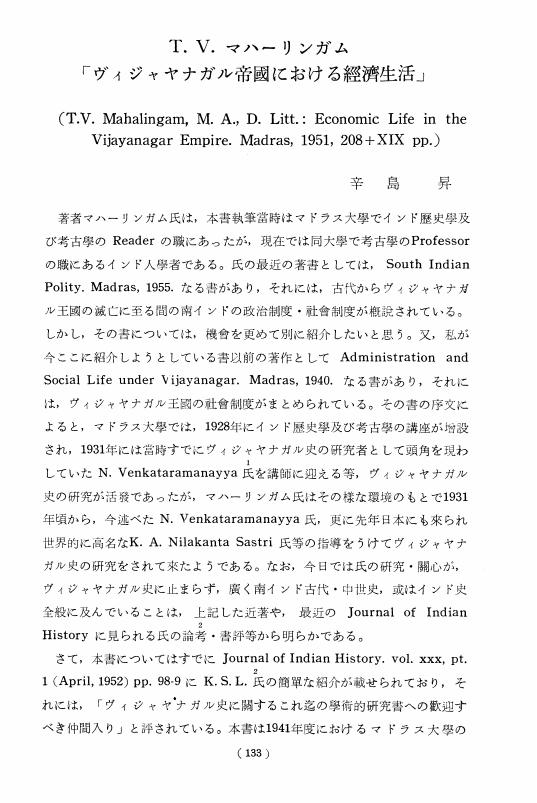1 0 0 0 OA パタニ國の王統について 17世紀のパタニ國 I
- 著者
- 永積 昭
- 出版者
- 東南アジア学会
- 雑誌
- 南方史研究 (ISSN:2185050X)
- 巻号頁・発行日
- vol.1959, no.1, pp.56-70,A9, 1959-06-30 (Released:2010-10-22)
Concerning the Kingdom of Patani, situated on the eastern coast of the Malaya Peninsula, there exists an elaborate thesis, “De Factorijder Oostindische Compagnie to Patani” by Dr. H. Terpstra, s'Gravenhage 1938. (Verhandelingen van het Koninklijk Instituut voor de Taal-, Land- en Volkenkunde van Nederlandsch-Indie. Deel I). As in the beginning of the seventeenth century there were established a Dutch as well as an English Factory, we know a good many things about this kingdom. Dr. Terpstra, however, concentrated his interest on the activities of the Dutch, who were settled on the spot, but devoted little attention to the country itself. Therefore, the author would like to conduct some further investigation into this kingdom, in the first place royal lineage, by comparing European, Chinese and Japanese sources as far as possible.According to Tung hsi yang k'ao written by Chang hsieh the throne of Patani had been inherited by the male line until it became extinct in the Wan li era of the Ming dynasty. On the other hand, all of the European and Japanese material thereafter tells us that the kingdom was ruled by a queen, together with a younger lady (called “the young queen”) as her assistant and prospective successor, who left all political activities to a prime minister (called “the third king”).By means of the above mentioned documents from three sides, we can conclude that the male line of succession turned into the female one about the 14th year of Wan-li (1586). In the Itinerary of Jacob van Neck it is explicitly stated: “the Queen of Patani had ruled her kingdom for 15 years after the death of her husband.” This f act also tallies with some Chinese sources, though the latter don't mention the exact time of her enthronement.This first queen, given the title of “Pratiau” by the Siamese court, paid tributes every year, though it was merely nominal. Her title means nothing but “the king” and she was not known by any other name. She had at least two sisters, one of whom got married to a king of Pahang in 1584. Later, this queen of Pahang became the cause of conflict between both countries simply because the king of Pahang did not allow his spouse to visit her sister for 28 years, which annoyed the latter. The Chinese document tells the conflict in a little different way. They say, in the beginning, there was a quarrel between Pahang and Johor, and Patani even supported her sister's state. We cannot ascertain which explanation is correct. At least it is certain that the warfare ended in the defeat of Pahang, and after the end of the war the royal couple came to Patani, leaving their devastated country behind them.This first queen Pratiau died of illness in August of 1616 and was soon succeeded by the other sister, then about 50 years old. During the earlier days of her reign Patani kept closer contact with the Dutch East India Company, although both Dutch and English Factories were withdrawn in 1622 and 1623 because of their economic inefficiency.At the time of the second queen, whose name is not known, Patani refused tribute to the Siamese court in 1629, denouncing the new Siamese king, Prasat Thong, as a usurper. This caused the invasion of its territory by Siamese troops in 1634, when the Dutch fleet also participated to attack the queen's territory. The result was that Patani was defeated and became dependent once more. 1) The second queen died in August, 1636, leaving her throne to one of her relatives. Thus her reign has lasted 17 years.(The travels written by Jean Albert de Mandelslo gives a different date to the death of the queen. However, when we submit his narrative to a careful scrutinization, we will notice that he borrowed almost all of his description from that of Jacob van Neck included in “Voyages” compiled by Isaac Commelin. Therefore this date hardly deserves our attention.)After the third queen, we c
1 0 0 0 OA 烏土の名稱について
- 著者
- 太田 常藏
- 出版者
- 東南アジア学会
- 雑誌
- 南方史研究 (ISSN:2185050X)
- 巻号頁・発行日
- vol.1959, no.1, pp.71-79,A12, 1959-06-30 (Released:2010-10-22)
‘Wu t'u’ is one of the names given to Burma. Yang Ping-nan's ‘Hai-lu’ is an important material, on the authority of which I have given careful consideration to the name of ‘Wu t'u’. The following may be suggested as the origins of ‘Wu t'u’:1. the land of ‘Hei-shui’ which means the River Irrawaddy.2. the transcription of ‘waddy’ from ‘Irrawaddy’.3. the transcription from Orissa, which is the home of the emigrants to Burma.4. the transcription of ‘waddy’ from Hamthawaddy, which is the name of ‘Talaing’ kingdom.Of the above, the last one (i. e. 4) is considered to be most apposite to the case for reasons given below:a. ‘Wu t'u’ was the name early given to Lower Burma.b. From ancient times until to-day, the Burmese had a great love for the name of ‘Hamthawaddy’.c. ‘Pegu-catechu’ was called ‘Wu-tieh-t'u’.Considerations have further been given in this report to the reason why opium is called ‘Wu t'u’, and suggestions made as to the origin of the name of ‘Po-ssu’ in South-East Asia which, like ‘Wu t'u’, may probably be the transcription of ‘waddy’ from Hamthawaddy.
1 0 0 0 OA コートン會社のビルマ通商について D. G. E. ホール「英緬初期交渉史」補遺
- 著者
- 荻原 弘明
- 出版者
- 東南アジア学会
- 雑誌
- 南方史研究 (ISSN:2185050X)
- 巻号頁・発行日
- vol.1959, no.1, pp.123-130, 1959-06-30 (Released:2010-10-22)
1 0 0 0 OA T. V. マハーリンガム「ヴィジャヤナガル帝國における經濟生活」
- 著者
- 辛島 昇
- 出版者
- 東南アジア学会
- 雑誌
- 南方史研究 (ISSN:2185050X)
- 巻号頁・発行日
- vol.1959, no.1, pp.133-141, 1959-06-30 (Released:2010-10-22)
- 著者
- 高畠 稔
- 出版者
- 東南アジア学会
- 雑誌
- 南方史研究 (ISSN:2185050X)
- 巻号頁・発行日
- vol.1959, no.1, pp.142-146, 1959-06-30 (Released:2010-10-22)


